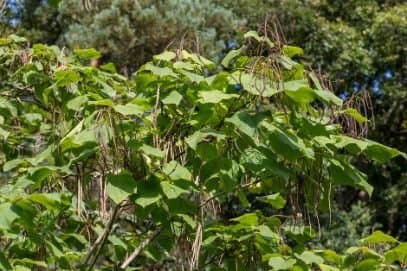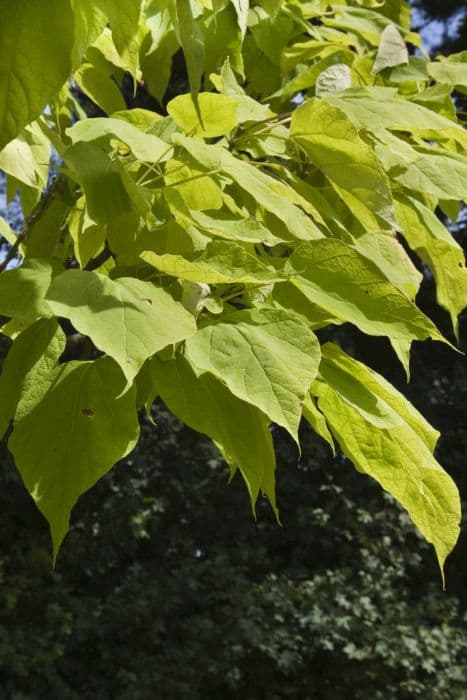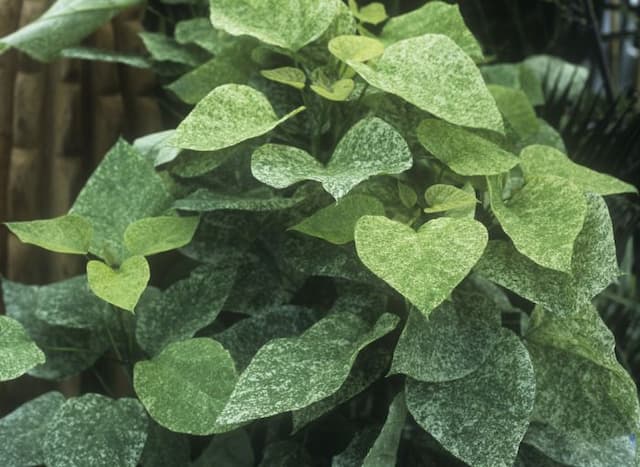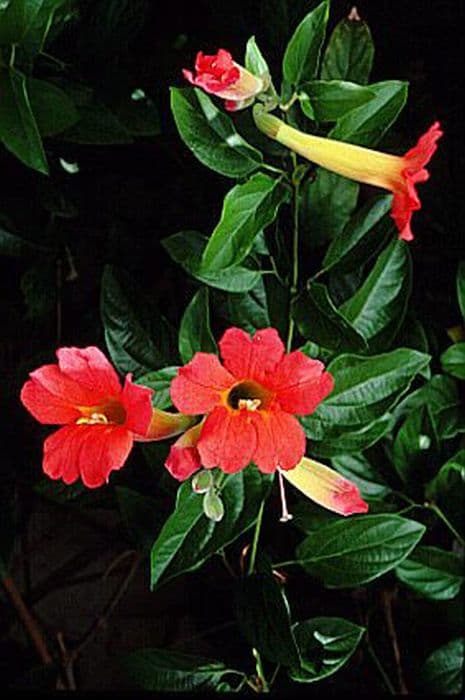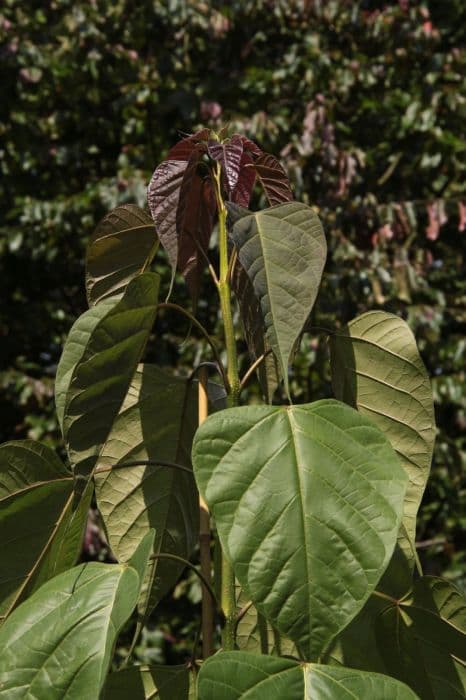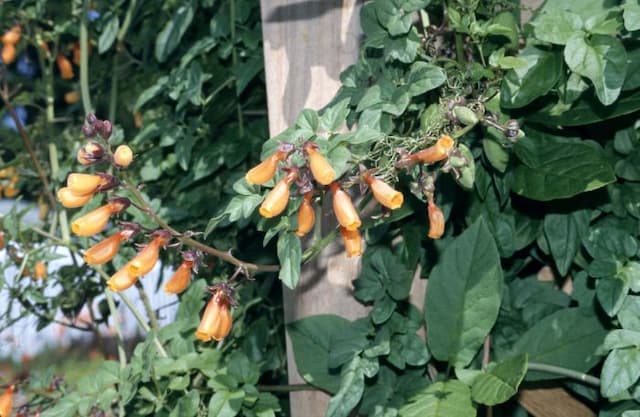Purple Catalpa Catalpa × erubescens 'Purpurea'

ABOUT
The Catalpa × erubescens 'Purpurea', commonly known as the Purple Catalpa, is an ornamental tree noted for its distinct appearance. The plant is characterized by its broad, heart-shaped leaves with a deep purple or reddish coloration when they first emerge. As the leaves mature, they generally transform to a green shade with a hint of purple remaining, especially on the undersides. During its blooming period, the Purple Catalpa showcases an impressive display of large, showy flowers that come together in dense clusters known as panicles. These flowers are typically white with speckles of yellow and purple, creating a striking contrast against the foliage. The flowers' trumpet-like shape is visually appealing and adds to the decorative quality of the tree. Following the flowering season, the plant produces long, slender seed pods that hang from the branches. These pods can add visual interest to the tree during the autumn and winter months when the leaves have fallen. The bark of the Purple Catalpa is also noteworthy, with a texture and pattern that adds to the plant's ornamental value throughout the year.
About this plant
 Names
NamesFamily
Bignoniaceae
Synonyms
Purple Catalpa, Purple-leafed Catalpa
Common names
Catalpa × erubescens 'Purpurea'.
 Toxicity
ToxicityTo humans
The Catalpa tree, commonly referred to in its variety as 'Purpurea', is not widely known to be toxic to humans. There is little evidence to suggest that ingesting parts of the Catalpa tree, such as its leaves, flowers, or seed pods, leads to poisoning in humans. However, as with many plants, individual sensitivities can vary and it's generally a good practice to avoid ingestion of plant parts not known to be edible. In the uncommon event of a reaction or if someone is suspected to have been poisoned by the Catalpa tree, it is important to consult a medical professional for a proper evaluation and treatment.
To pets
The Catalpa tree, commonly referred to in its variety as 'Purpurea', is also not widely recognized as being toxic to pets. There are no significant reports of pet poisonings from ingestion of parts of the Catalpa tree, such as leaves or seed pods. However, individual animals can have different sensitivities, and symptoms of an upset stomach could occur if a pet ingests a large quantity of plant material. If a pet owner suspects their animal has ingested Catalpa tree parts and is showing signs of distress, they should contact a veterinarian for appropriate advice and treatment.
 Characteristics
CharacteristicsLife cycle
Perennials
Foliage type
Deciduous
Color of leaves
Green
Flower color
White
Height
20-30 feet (6-9 meters)
Spread
15-20 feet (4.5-6 meters)
Plant type
Tree
Hardiness zones
5
Native area
Cultivar
Benefits
 General Benefits
General Benefits- Aesthetic Appeal: The 'Purpurea' variety of Catalpa is known for its stunning purple foliage in spring, which turns green as it matures, providing an attractive display.
- Shade Provider: With large, heart-shaped leaves, the tree creates a broad canopy that offers valuable shade in gardens and parks.
- Ornamental Flowers: Produces large, showy clusters of white flowers, often with purple and yellow markings, which can enhance the beauty of landscaping.
- Wildlife Habitat: The flowers attract bees, butterflies, and hummingbirds, which can help pollinate other plants in the area.
- Seasonal Interest: Provides visual interest through multiple seasons with changing leaf colors, blooms in summer, and long seed pods in autumn.
- Durable Wood: Catalpa wood is relatively resistant to rot and can be used for outdoor applications like fence posts or in carpentry.
 Medical Properties
Medical PropertiesThis plant is not used for medical purposes.
 Air-purifying Qualities
Air-purifying QualitiesThis plant is not specifically known for air purifying qualities.
 Other Uses
Other Uses- Catalpa × erubescens 'Purpurea', commonly known as Purple Catalpa, can be used as a natural dye source. The leaves and bark can produce dyes for fabric and yarn.
- The wood of the Purple Catalpa is fine-grained and easy to work with, making it suitable for creating small wooden objects like bowls or decorative items.
- The large leaves of the Purple Catalpa can be used in crafts for impression art, where they are coated with paint and pressed onto a surface to leave a leaf-shaped mark.
- Purple Catalpa's spreading canopy provides an excellent shade for outdoor sitting areas, and its dense foliage can create a private and cool space during hot summers.
- Birds, especially hummingbirds, are attracted to the nectar of Purple Catalpa flowers, making it an ideal plant for bird watchers to attract avian visitors to their gardens.
- The strong branches can be used for creating natural play structures for children, such as simple swings or climbing frames.
- Purple Catalpa's seed pods, which resemble beans, can be utilized in crafts and decoration, for example, as elements in dried flower arrangements or wreaths.
- The fallen leaves can act as a natural mulch, providing nutrients to garden beds while suppressing weeds around other plants.
- The tree can be planted as part of a windbreak arrangement that can help to reduce wind speed and erosion in exposed areas.
- With its distinctive looks, the Purple Catalpa is used as a focal point in landscape design, drawing the eye with its shape, foliage, and flowering habits.
Interesting Facts
 Feng Shui
Feng ShuiThe Catalpa is not used in Feng Shui practice.
 Zodiac Sign Compitability
Zodiac Sign CompitabilityThe Catalpa is not used in astrology practice.
 Plant Symbolism
Plant Symbolism- Endurance: The Catalpa > 'Purpurea', commonly known as Purple Catalpa, is known to be a hardy tree that can withstand tough conditions. Its resilience is often equated with endurance and perseverance in the face of adversity.
- Protection: With its large leaves that offer abundant shade, the Purple Catalpa is sometimes symbolic of protection and shelter. It can represent the safety and comfort provided by a larger, nurturing presence.
- Uniqueness: The Purple Catalpa's striking appearance, with its dark purple leaves compared to more common green-leaved trees, may symbolize individuality and the beauty of being unique or standing out from the crowd.
- Adaptability: This hybrid tree shows adaptability by thriving in a range of environmental conditions, symbolizing flexibility and the ability to thrive in various life situations.
- Healing: In some cultures, parts of the Catalpa tree are used for medicinal purposes, which lends this plant the symbolic meaning of healing and health.
 Water
WaterThe Purple Catalpa should be watered deeply and thoroughly, ensuring that water reaches the roots, rather than just wetting the surface. During the growing season, water the tree approximately once a week with about 1 to 1.5 gallons per inch of trunk diameter at chest height. In the absence of rain, continue this routine, allowing the soil to dry out slightly between waterings. During the winter, reduce watering frequency, but do not allow the soil to become completely dry. It is important to avoid over-watering as this can lead to root rot.
 Light
LightPurple Catalpa thrives best in full sun to partial shade. Planting it in a location that receives at least six hours of direct sunlight each day will ensure vigorous growth and flowering. While it can tolerate some shade, too much can reduce the tree's bloom and can lead to a less robust plant.
 Temperature
TemperatureThe Purple Catalpa is adaptable to a range of temperature conditions; however, it grows best within a temperature range of 60°F to 90°F. It can tolerate winters with brief periods as low as -20°F. Avoid placing it in locations where temperatures frequently drop below this range, as that can cause damage to the tree.
 Pruning
PruningPruning the Purple Catalpa is generally done to maintain shape, remove damaged limbs, and encourage a strong structure. The best time to prune is in late winter or early spring before new growth starts. Pruning should be performed as needed, based on the tree's appearance and health, to remove dead wood and thin out dense branches, which allows light to penetrate and air to circulate more effectively throughout the canopy.
 Cleaning
CleaningAs needed
 Soil
SoilThe Purple Catalpa prefers well-drained soil with a pH range of 5.5 to 7.0. For an ideal soil mix, combine loamy soil, peat, and sand to ensure proper drainage while retaining some moisture.
 Repotting
RepottingThe Purple Catalpa, being a sizeable outdoor tree, does not require frequent repotting. Transplanting should only occur if necessary, typically when it outgrows its current location.
 Humidity & Misting
Humidity & MistingPurple Catalpa thrives in average outdoor humidity levels; it does not require specific humidity adjustments when planted in garden settings.
 Suitable locations
Suitable locationsIndoor
Not suited for indoor growth; Purple Catalpa is a large outdoor tree.
Outdoor
Plant in full sun with well-draining soil; not for small gardens.
Hardiness zone
5-9 USDA
 Life cycle
Life cycleThe Catalpa × erubescens 'Purpurea', commonly known as Purple Catalpa, begins its life as a seed which, when planted in well-draining soil and exposed to sunlight and warmth, will germinate and sprout. The sprout develops into a seedling with characteristic heart-shaped leaves, which may start out with a purplish tinge before becoming greener as it matures. As it enters the vegetative stage, the plant focuses on leaf and stem growth, eventually reaching its full size and beginning to form a sturdy trunk. The Purple Catalpa reaches maturity in a few years and starts flowering, producing white to pale pink flowers with yellow and purple markings, typically in late spring to early summer. After pollination, the flowers develop into long, slender seed pods that persist into the winter. The tree then goes into a period of dormancy during the cold months, dropping its leaves, and will resume its growth cycle with new foliage in the spring.
 Propogation
PropogationPropogation time
Spring-Early Summer
The most popular method for propagating the Catalpa × erubescens 'Purpurea', commonly known as the Purpurea Catalpa, is through softwood cuttings. This is typically done in late spring or early summer when new growth is still supple and green. To propagate via cuttings, one should select a healthy, disease-free branch and make a cutting about 6 to 8 inches (15 to 20 centimeters) long, ensuring there are at least two sets of leaves. The bottom set of leaves is removed, and the cut end can be dipped in a rooting hormone powder to encourage root development. The cuttings are then placed in a moist, well-draining growing medium such as a mix of peat and perlite, and kept under high humidity and indirect light until roots have established, which usually takes several weeks.
